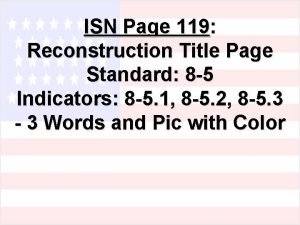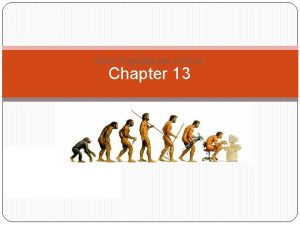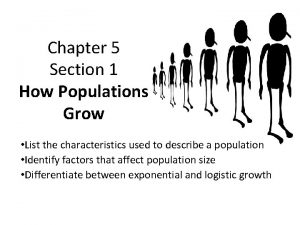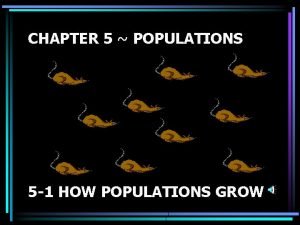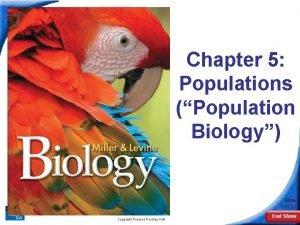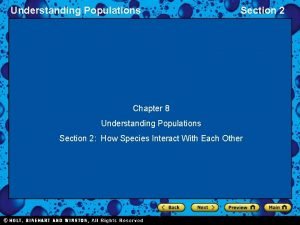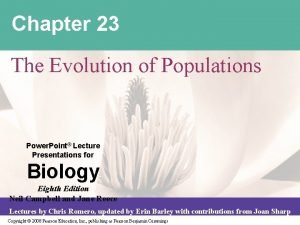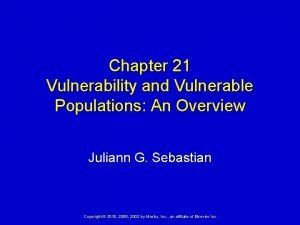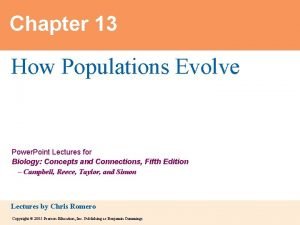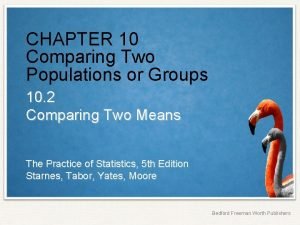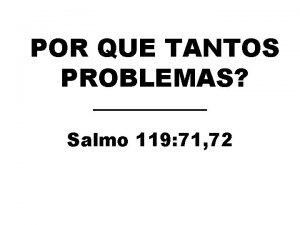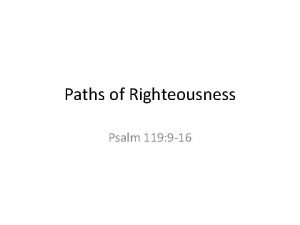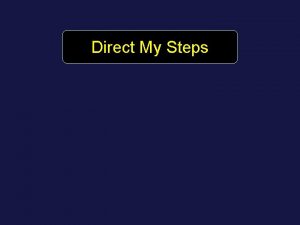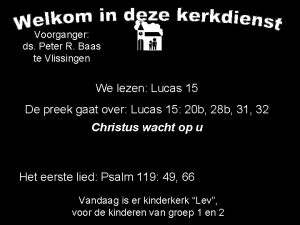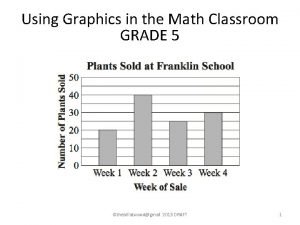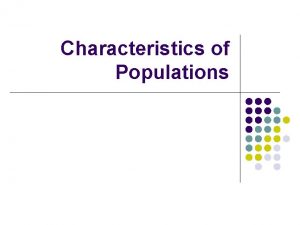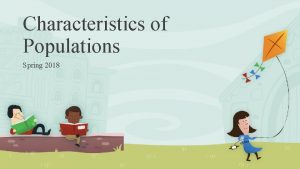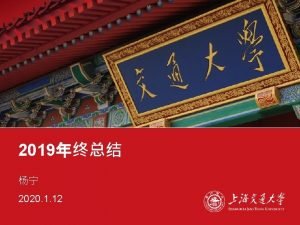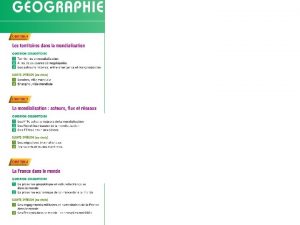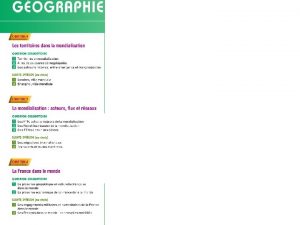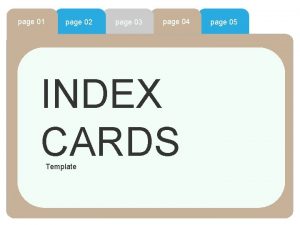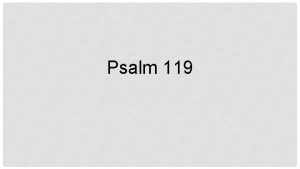Populations Chapter 5 Page 119 Characteristics of Populations









































- Slides: 41

Populations Chapter 5, Page 119

Characteristics of Populations n n n 4 important characteristics of a population are; 1. Geographic distribution, 2. Density 3. Growth rate and 4. Age Structure.

Geographic Distribution n This is the range or area inhabited by a population n Another term would be the “range”.

Population Density n The number of individuals per unit area. n This number varies depending on the species and its ecosystem. n The equation is: Population density = number of individuals divided by/over the unit area

Population Growth n n n n Can grow rapidly Can decrease in size Can stay the same size from year to year 3 Factors can affect population size: 1. The number of births, 2. the number of deaths and 3. the number of individuals that enter or leave the population.

Immigration n The movement of individuals into an area causes the population to grow.

Emigration n The movement of individuals out of a population causes that population to decrease in size.

Abundant food? n If a population has abundant space and food and is protected from predators and disease, the population will multiply and the size of the population will increase

Exponential Growth n n This occurs when the individuals in a population reproduce at a constant rate. You normally will see a “J” shaped curve in the graph

Growth Rate n The growth rate may be stated in 3 ways; n 1. Doubling time 2. A birthrate per female 3. A percentage of growth per year. n n

Logistic Growth n n n Logistic growth occurs when a population’s growth slows or stops following a period of exponential growth. It slows when a populations birthrate and death-rate are the same, and/or the rate of immigration is equal to the rate of emigration. You will normally see an “S” shaped curve on the graph

Logistic Growth Curve

Carrying Capacity n The largest number of individuals that a given environment can support.

Figure 5 -4 Logistic Growth of Yeast Population Section 5 -1 Number of Yeast Cells Carrying capacity Time (hours) Go to Section:

Limiting Factor n A factor that causes population growth to decrease.

Limiting Factors affecting Populations n n Some limiting factors affect a population more strongly as the population grows larger. Example-Competition, Predation, Parasitism, disease. Other limiting factors limit a population’s growth regardless of the size of the population. Example-natural disasters, damming rivers, clear cutting forests.

Density-Dependent Limiting Factors n This is a limiting factor that depends on a BIG population size. n These become limiting only when the population reaches a certain size. (Large and dense) n Includes: Competition, Predation, Parasitism, Disease

Density Independent Factors n n This is a limiting factor that affects all populations in similar ways, regardless of population size. Include: Unusual weather, Natural disasters, seasonal cycles and Human activities– damming rivers, clear cutting forests, etc.

Changes Caused by Density Independent Factors n n Most populations can adapt to a certain amount of change Periodic droughts can affect entire populations of grasses Major upsets in an ecosystem can lead to long term declines in certain populations A response to this factor would be that the population crashes.

Competition n n n When populations become crowded, organisms compete for; food water space sunlight and other essentials like clothes

SB 4 c & d What effect did the loss of species B have on species A and D in Figure 5 -3? a. it caused the populations of A and D to decrease b. it caused the populations of A and D to increase c. it caused the populations of A and D to become extinct d. it had no effect on the populations of A and D

SB 4 c & d Examine the graph in Figure 5 -3. Which species were not affected by the loss of species B? a. species A, C, and E c. species C only b. species C and E d. species E only

Mechanism of Population Control n n Would be the predator-prey relationship On Isle Royale, the moose were the prey and the wolves were the predators If the moose population were to decline then so would the wolves since there is not enough for the wolves to eat. Parasites are like predators because they take nourishment at the expense of the host which weakens them causing disease or death

Figure 5 -7 Wolf and Moose Populations on Isle Royale Section 5 -2 60 2400 50 2000 40 1600 30 1200 20 800 10 400 0 1955 1960 1965 1970 1975 Moose Go to Section: 1980 Wolves 1985 1990 1995 0

Island Area (km 2) A B C 850, 000 300, 000 90, 000 Initial No. of Species 175 140 80 Extinctions 25 35 50 SB 4 c & d According to the data in Table 5 -2, which factor has the greatest impact on species loss? a. the original number of species c. the area of the island b. the distance from the mainland d. the climate

III. Natural selection and sexual selection Directional selection 2) Number of individuals 3) def: selection that results in allelic frequency moving in one direction Overview Example Range of values at time 2 Range of values at time 1 Number of individuals 1) Number of individuals A. Range of values at time 3

Number of individuals Range of values at time 1 B. Stabilizing selection Number of individuals 1) effect: there is no change in average value for a trait, and variation is reduced 2) Overview Number of individuals Range of values at time 2 Range of values at time 3

3) Number of individuals 2) Eliminates average phenotypes and favors extremes Overview Range of values at time 1 Very important: can lead to speciation- creation of new species Range of values at time 2 Number of individuals 1) Number of individuals C. Disruptive selection Range of values at time 3

Historical Overview of Human Population n n The size of the human population increased with time It was slow at first due to life being harsh and limiting factors kept population sizes low It began to grow again because of improved sanitation, industry made life easier and safer and the world’s food supply became more reliable The human population cannot keep growing exponentially because the Earth and its resources are limited

Demography n Demography is the scientific study of human populations. n Factors include; birthrates, death rates and the age structure of the populations.

Demographic Transition n n This is the hypothesis that explains why population growth has slowed dramatically in the United States, Japan and much of Europe. Birthrates and death rates fall during the demographic transition. Initially, both rates are high then the death rate drops while the birthrate remains high and finally the birthrate also decreases. This process is demographic transition.

Human History n n n Societies have had high birthrates and equally high death rates Advances in nutrition, sanitation, and medicine have lowered the death rate Changes brought about by modernization lower the death rate Births greatly exceed deaths, resulting in rapid population increases As modernization continues, the birthrate falls and population growth decreases The birthrate falls to meet the death rate, and population stops

Human Population Growth n n The worldwide human population is still growing exponentially Most people live in countries that have not yet completed the demographic transition The demographic transition has happened in the U. S. Population growth depends on how many people of different ages make up a given population.

Population growth rates by place

Figure 5 -13 Age Distribution Section 5 -3 U. S. Population Males Go to Section: Females Rwandan Population Males Females

Age structure and sex ratios of a population


Age Structures n The age structure in the US predicts a slow but steady growth rate for the near future. n The age structure in Rwanda predicts a population that will double in about 30 years.

Women’s roles

Future Population Growth n n n By the year 2050 the worlds population may reach more than 9 BILLION people. http: //math. berkeley. edu/~galen/popclk. html To level this off or slow it down, countries of the world that are currently growing rapidly move toward the demographic transition. http: //www. poodwaddle. com/worldclock. swf http: //www. census. gov/population/www/popcloc kus. html

Future Growth n n n If the growth in human population does not slow down, ecologists suggest that there could be serious and lasting damage to the environment as well as to the global economy. http: //www. myfootprint. org/ What is your ecological footprint?
 Think pair and share page 119-120
Think pair and share page 119-120 Page 119
Page 119 Apa paper format title page
Apa paper format title page Chapter 16 evolution of populations vocabulary review
Chapter 16 evolution of populations vocabulary review Chapter 13 how populations evolve test
Chapter 13 how populations evolve test Chapter 17 evolution of populations answer key
Chapter 17 evolution of populations answer key 5-1 how populations grow
5-1 how populations grow Chapter 5 lesson 1 how populations grow
Chapter 5 lesson 1 how populations grow Chapter 23 the evolution of populations
Chapter 23 the evolution of populations Chapter 16 evolution of populations
Chapter 16 evolution of populations Chapter 10 comparing two populations or groups crossword
Chapter 10 comparing two populations or groups crossword Chapter 5 lesson 1 how populations grow
Chapter 5 lesson 1 how populations grow Chapter 8 understanding populations
Chapter 8 understanding populations Chapter 23 the evolution of populations
Chapter 23 the evolution of populations Chapter 21 vulnerability and vulnerable populations
Chapter 21 vulnerability and vulnerable populations Chapter 13 how populations evolve
Chapter 13 how populations evolve Chapter 10 comparing two populations or groups
Chapter 10 comparing two populations or groups Salmo 119:126
Salmo 119:126 Lei nº4.119/1962
Lei nº4.119/1962 Comment le jeune homme rendra
Comment le jeune homme rendra Psalms 119:105 nlt
Psalms 119:105 nlt Psalm 119:9-11 kjv
Psalm 119:9-11 kjv Salmo 119:71-72
Salmo 119:71-72 Psalm 119:9-16
Psalm 119:9-16 Hbu 112 uitm
Hbu 112 uitm Psalms 119 meditation
Psalms 119 meditation How does a typhoon form
How does a typhoon form Psalm 119 verse 17-24
Psalm 119 verse 17-24 Psaume 119:105
Psaume 119:105 119 times 2
119 times 2 Mat 119
Mat 119 Ontario's equity and inclusive education strategy
Ontario's equity and inclusive education strategy Psalm 119:9 nkjv
Psalm 119:9 nkjv Direct my steps by your word
Direct my steps by your word Psalm 119 overview
Psalm 119 overview Gezang 90
Gezang 90 Psalm 119:160
Psalm 119:160 Salmo 119 99
Salmo 119 99 Nab 119:105
Nab 119:105 Psalm 119:33-40 nkjv
Psalm 119:33-40 nkjv Psalm 119:99-100
Psalm 119:99-100 Number sense
Number sense

